My Recollection.
Raphael was right, you do gotta know what a crumpet is to understand cricket. Crumpets are an odd breakfast toastable. They look like warts, they feel like warts, and, due to a lack of data, I’m going to assume they actually taste like warts. Just warts you’ve drizzled warm honey onto, which is why, due to a lack of data, I’m going to assume they were invented by a British private school principal whom people avoid talking about.
Australian Cricket is the honey-drenched wart of sports. In its home nation of England, it was a sensible way to stand outside for the UK’s 5 days of sunlight per year. It then migrated to India, the West Indies, and Australia where the sun is less a lifegiving orb worthy of worship and more a giant, floating Chernobyl you have to hide from for 9 months. About the worst thing you could come up with in Australia is a sport that necessitates a bunch of people just stand outside for eight hours but I’d say the same thing about sweetened wart-meat, so here we are.
It’s popular with disorganised suburban ferals because the backyard version of the game actually resembles the real thing. Backyard rugby, either code, degenerates into a half-dozen regular sized children attempting to tackle that one structural support Samoan every Australian suburb has. Fun as it is to summit one of those mighty beings, it’s a far cry from a meaningful sport. Backyard cricket involves numbers you can use to win.
A baseball bat is round making it more of a distended handle than a bat. A cricket bat has a handle, and mass of shock resistant willow shaped like a drunk Mesoamerican pyramid. This ridgeback design supports the flat striking surface of the bat, turning it into a tool of pure Wallop Energy. A standard game involves someone straight-arm hurling a crimson rock of calcified hate we call a “cricket ball” at your younger neighbour’s genitals, and them attempting to defend themselves from this with a glorified macuahuitl.
You have to hit the ball far enough away that you can scoot back and forth between the pair of wheelie bins that designate the pitch without someone hitting either bin while you’re running toward it. If you’re near the bin, you’re safe. If they catch the ball on the full, you’re out. In the backyard, you get a turn batting when you get someone out. My brother really wanted a turn at the bat one afternoon.
Cricket is a game of strategy played by erstwhile labourers who have already had anything meaningful baked out of their brains by the cruel Australian sun. If someone hits the ball far, you move your guys out there; if they are hitting it close, you move your guys closer. Bearing in mind that “closer” means a dangerous proximity to the interaction of adamantium sphere and Aztec murder weapon. Pros have helmets and all sorts of other protective gear to keep them safe enough to do ads for Milo and hair growth products in their old age. The backyard has no such protections.
My brother had scooched close to the batsman, well, batschild, as the fumbling seven-year-old was coordinated enough to glance ball with bat, making his drizzling shots prime material for an easy catch.
Another fundamental element of Australian backyard sports is bullying. Bullying in the feral suburbs works a bit like radiation in the Marvel universe in that it sometimes works the opposite of how medical science says it should. Every now and again, some feeble weakling would snap and manage a feat of Herculean bravery or strength that would ensure he wouldn’t be fucked with again for at least 6 months. Batschild was too small for the adult bat and was waving it about the way a cartoon character wields a fire hose. He was batting only because he was first, and by letting him have it we could ensure he’d stay on in the unbelievably boring job of fielding after he was inevitably ousted. He was also copping it from everyone. Eventually, an older boy gave him a basic pointer on moving before you swing the bat. Nobody thought it would take, and my brother scooched even closer.
It still wasn’t a good swing. His feet weren’t grounded, his hip swing was a bit early, and his grip was kinda fucky, but that didn’t matter really because he got enough done to swing the bat on a savage arc through the air. It was nowhere near the ball, his swing was so insanely powerful it dragged him with it to the position my brother was in, a site named, I kid you not, Silly Point.
I can still see my brother, keeping his eye on the ball as it bounced some 50 centimetres below and away from the bat that was swinging for his forehead like Huitzilopochtli himself was holding it.
The flat walloping surface of a cricket bat meeting the flat walloping surface of an Australian boy’s forehead makes the kind of sound that scares thunder while it sleeps. Everyone winced that way you see a group of cats do when something in the room makes a loud noise as the bat that’s designed with an impact absorbing ridge to keep from breaking broke over my brother’s head.
Backyard cricket has rules the real game doesn’t. Like six-and-out, a rule that states if you hit the ball either far enough away that it’s really annoying to have to go get it or into a yard that contains a malnourished mongrel or adult retard who tries to grope you, the inconvenience means this normally amazing shot also means you’re out. A bit like LBW, this is something that has to be appealed for and argued about. One that’s unspoken and requires no appeal is the, “Did we just kill someone?” rule. So, the game froze.
Fortunately, while the bat was an adult bat, and still defined as “the good bat” it had spent some time in the rain, meaning my brother’s skull had a fighting chance. He was floored, but squirming and complaining pretty much immediately, meaning the game got to continue and the rest of our time in that suburb he was famous for having a seemingly unbreakable head.
I don’t think baseball lets you get close enough to get hit with the bat, which is an admirably sensible move.
The Episode.
There’s a thing in education called the Zone of Proximal Development. It was developed by Lev Vygotsky and describes the space where a student cannot develop further on their own but can do so with skilful assistance. If you imagine you’re stretching your leg and can only raise it so far, you are able to go a little further when someone raises it for you, the space between where you can go yourself and where you can be helped to is the ZPD. This, of course, grows as you do, meaning you will reach levels of development that would have seemed impossible to your earlier self, and this basic concept is how the whole of education works.
Putting Simpsons Roasting on an Open Fire and Deep Space Homer beside each other is the equivalent of me reefing your leg from where you can go now to where you’d be able to go after several years of practise. That tendon snapping sound you’re hearing is the physical equivalent of what your brain does when you see a skill that is far beyond your ZPD.
But we do eventually get to Deep Space Homer. In fact, we get several layers of ridiculous beyond, and all within even the narrower ranges of the Classic Period. This feat is accomplished through episodes like Homer at the Bat, which uses another Vygotskyan tool, scaffolding.
South Park once took a stab at Family Guy’s style of humour by having Cartman say that what he did was funny within the contexts he found himself in. The greater point being made by whoever wrote that line was that jokes are easy when you have abandoned all contextual bounds. Family Guy’s use of cutaways frees writers from having to build a connection between the joke they want to make and the scene, characters, or story they are writing. If your joke involves a fridge, and your character isn’t near a fridge, it doesn’t matter because you can just have the character be near a fridge. It’s true, the technique is staggeringly lazy, but it’s a somewhat hollow point when Cartman’s contexts include Towelie. One may lazily change the setting to one where a fridge exists as needed but having an episode where a gnome is making fridges appear randomly is better by only a small margin.
A show about a nuclear family and a show about four fourth-grade children have equal natural claim to reality bending battles between monsters or enormous musical numbers, but what Family Guy does with cutaways South Park did by establishing an initial reality that was cutaway flexible from the start. South Park and Family Guy can do this because they were birthed into a world where animated sitcom realism was well established. The Simpsons came from an era where it was having to fight against perceptions of animated reality set by things like Warner Bros. cartoons and this limited the early series ZPD.
Homer at the Bat is a stunt episode. There’s no real theme, moral, lesson, or character moments of any depth. The elements of the plot that veer close to those are simply the familiar elements the stretch needs to work, part of the reactive nature of the show’s relationship to prior sitcoms. Homer’s bottom of the 9th moment of glory is twisted into a successful-in-spite-of-itself failure, while the old morals of “do your best” and the like are turned into “can’t win; don’t try”.
But stunt episodes still need to work and this one does. Firstly, the obvious factor is that, by season three, what was once the outer limit of the audience’s ZPD is now the new normal. The series needed its reality because it’s not where a thing is that’s funny, but the relative stretch away from where it started. Learning is the space between the known and the unknown, not either pole. Once that reality level was taught, it opened the new edges of the ZPD. The second is that this episode performs its stretching through an understandable intermediary, the episode’s Vygotskyan scaffold, Mr Burns.
We all have something we think that’s absolutely stupid. Not any deeply held belief, more like the kind of factoids that an uncle said to us when we were 6 that we just never otherwise think about, like “dogs can’t look up”. These things act as windows into unreality that shows can use for leverage, and Mr Burns, a 104-year-old plutocrat, is a ball of them. Do you know how deranged old billionaires spend their time? Of course not, and the odd thing that does leak out tends to be of the absurd variety, so audiences are primed with unexamined cultural blind spots. Billionaires do crazy things so a billionaire doing a crazy thing, even when it’s really weird, fits a mental template for normal.
Much later episodes could say that a town/suburb like Springfield has a Wimbledon-scale tennis tournament and have star tennis players just be there with no setup, but this stretch would snap season three’s tendon. A crazy, old-timey character and enough money can explain nearly anything, so now there’s as good as a perfectly good reason for several Hall of Fame grade baseball players to be appearing in this episode. It’s a step that takes work, which you can tell because they eventually stop bothering. After a while, The Simpsons becomes a show that exists in the wake of Family Guy and South Park, not the other way around.
This is a silly episode. It has no real focus, is the story about Homer, Homer’s bat, Homer being what made the bat special, Burns, what? None of these threads are focused on because they barely exist as parody referents to be inverted and mocked. They’re just a light frame to stabilise the rest. But it’s a good silly episode because here it’s still a sometimes food and not the overexposed result of a worn-out narrative universe. It’s a good one because ridiculous things like the stunt casting of several US sports legends is given a reason that fits the show’s reality. It’s a good one because it uses Mr Burns as a scaffold to support the extension of the ZPD, meaning that the particularly silly things—The Springfield Mystery Spot, chicken hypnosis, gigantism, and Jose Canseco—flex the tendon as opposed to snapping it.
Homer at the Bat is the kind of good dumb that takes work and a sort of educational episode that becomes a template for other, great stunt episodes.
Yours in being invited to the party in Ken Griffey Jr’s mouth, Gabriel.
Jokes, Lines, and Stray Thoughts.
A good story is self-contained because things that aren’t set up will feel like the unfair flippancies of a writer-god. Using Homer’s established love of donuts to get him choking to get Lenny to look at walls for the Heimlich chart to have him see the softball sign-up sheet is a level of internal tightness we don’t deserve.
The goddamn stills we get from Homer gorging and then choking on the donuts are absolute gems. I love these things because you could catch glimpses of them back when frame advancing was basically impossible and never be quite sure of what you saw.
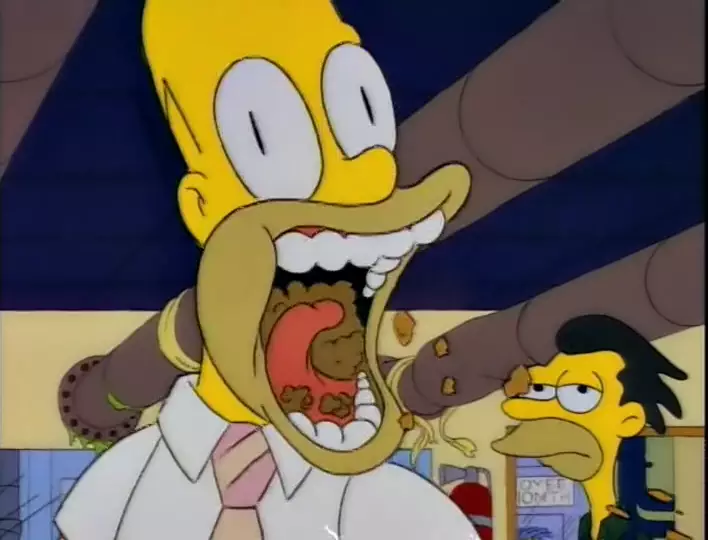
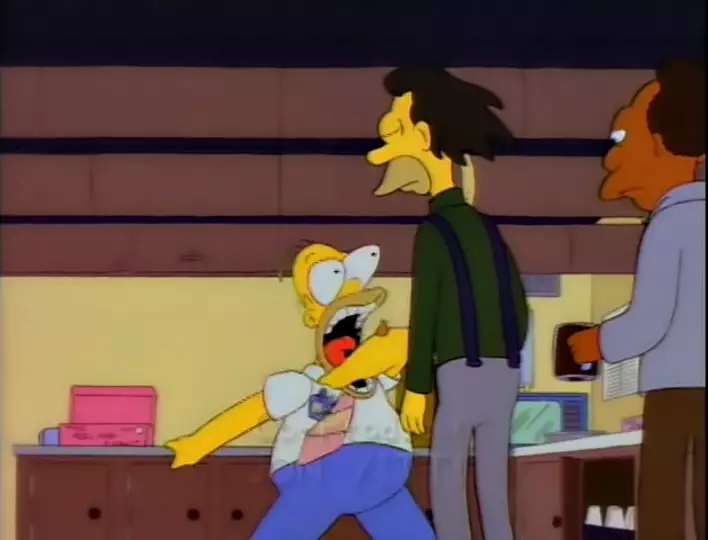
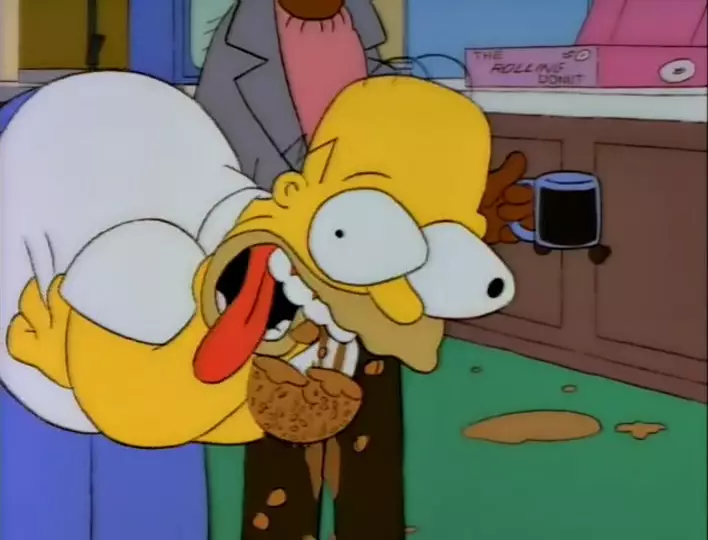
Homer gets 9½ donuts in him before he starts to choke, which is a fucking lot of the things.
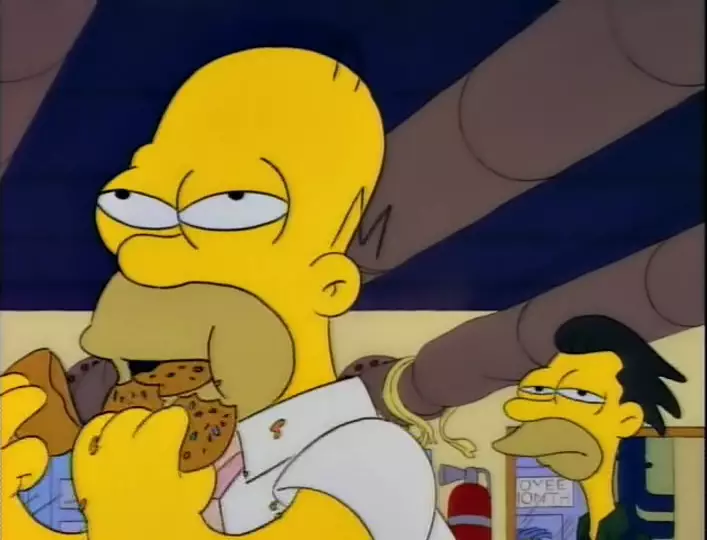
“Somebody scare ‘im” is so perfectly on the cusp of too ridiculous.
The Heimlich poster involving a whole lobster is a good sight gag, nice and brief.
This is one of those episodes that features a temporary Homer thing, like his interest in fishing in War of the Simpsons. Homer has been, and is generally defined as, dismally unfit, incapable of even the most basic of exercise or athletics. Now, he’s not only capable of connecting bat to ball, but he is actually seen running.
“Look, I know it wasn’t our best season.” “Actually, it was” is a good little run.
The imagined secret weapons escalate nicely. Lenny’s dumb chuckle at the laser works well to shave some of the extremity of it off, as though even he finds it funny.
All white people look the same to Carl.
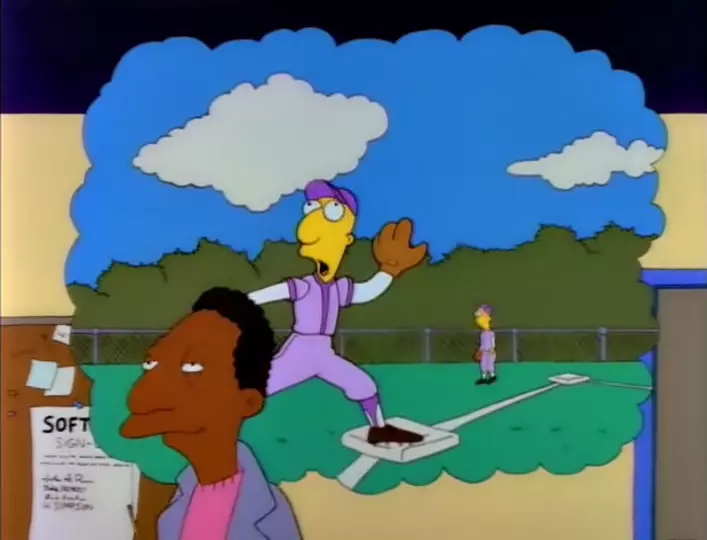
Bart guessing what Homer was about to show him and Homer not even registering works great as both a joke and a piece of characterisation.
This whole sequence is from a baseball movie The Natural which I haven’t seen.
The homemade football is hilarious for a lot of obvious reasons but what always got me was how unnecessary it was.
The general run of jokes on the bat construction—nails, welding, etc—are reasonably funny, but the bat turns out remarkably well considering our other examples of Homer’s handiwork. It’s one of those moments where they wrote themselves into a corner.
The normal pattern with a plot device like the bat would be to have it destroyed, which it is, have Homer doubt himself, then realise that the skill was in him and not the bat. Part of the lackadaisical construction of the episode is that we get the standard parts of that, but no real resolution to it, even in a parodic sense. The bat’s destroyed, but that doesn’t matter really as it’s immediately forgotten as a plot point. We don’t get the “it was me all along” because the threat isn’t a broken bat but the presence of manifestly superior players. Believing in yourself won’t make a fat 37-year-old man better than Darryl Strawberry in his prime years, so the pattern just fizzles out into nothing.
As someone who has played sports fairly drunk, I don’t recommend drinking that much during a sport.
I want Marge to commentate Evo.
Similar to how Homer will be moulded to fit a variety of generic father stereotypes, the rest of the family will typically get dragged along. The kids and Marge are not always as supportive or interested in sports as they are here, but they’re tweaked to fit the story.
A look at a variety of Springfield police we otherwise never see.
The guy who gets brained by Homer’s homer used to show up more but got lost in the shuffle as the primary cast expanded to absorb the whole town.
Like, I know a softball pitch from a fat cop isn’t gonna be lightning but belting one of those things out of the field still requires a fair bit of strength and coordination.
And he runs, RUNS!
“You can each get me a beer”
Super slow mo on a VCR was abso-fucking-lutely shithouse. The ability to freeze frame video in a way that lets you clearly see each frame is a luxury of the digital world. Pausing videotape was using a mechanical system to stop a ribbon of plastic against a whirling metal drum. Even if your VCR had frame advance, and you weren’t just pause/unpausing it to try and see something, the visual quality was fucking shithouse and would usually have those artefacts you now only see as quaint affectations in vapourwave videos. Things like Homer’s belly would have been impossible to register for a home VCR.

The extra “Huh?” as Homer realises he hit it is a nice addition.
Things like the train montage parody baseball movies and work as a decent joke via the absurdity of taking a steam train anywhere within a single suburb to play a local softball tournament.
Homer making a show of thinking before smugly changing his shot call is funny.
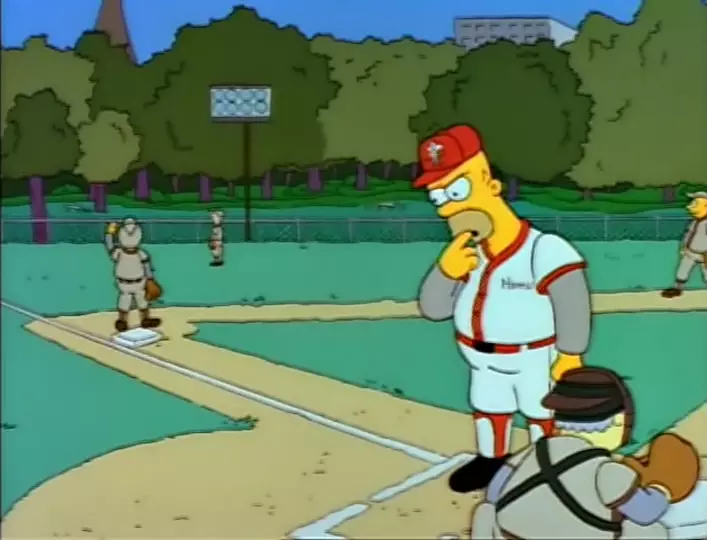
Some writers in the front row at Fort Springfield, featuring one that would go on to become the model for one of the nerds. A kind of early form of Roger Meyers Jr. is here too.

Sherrie or Terrie with some real bug eyes.
The word wallop is just a funny word. You hear it a fair bit in Australia.
The run of other magic bats is pretty good. I kinda wanna see someone try to use a prosthetic leg.
I’m assuming there’s rules about what you’re allowed to use as a bat, or is this one of those “no rule that dogs can’t play” situations?
A slight look at Springfield becoming a microcosm of the whole US with the Springfield Trade Centre. As a location, Springfield is probably a bit more open to reality flexibility, after all, think of all the places in your town you don’t ever go to or look at, but things like a small suburb having it’s own skyscraper financial district certainly are stretches.
Not Jon Lovitz as Aristotle. Castellaneta filled in but it’s an audibly generic voice.
Burns’ thing on his mind being elsewhere is a nice moment as it’s a very familiar thing in a wildly unfamiliar setting.
“Let me rephrase that” is a perfectly delivered line and the turn of Burns’ head while Smithers smiles and changes his mind without any hint of interfering self-awareness is a beautiful moment.
The dangerously efficient Smithers who nonchalantly asks who Burns wants killed is an early thing that we lose after a while. I like it as a facet of him, gives him some depth. It shows up again in Marge gets a Job.
Apparently, Burns’ ancient ringers are a real baseball nerd crew, featuring rarities one would have to be a real enthusiast to even be aware of in a pre-internet era.
The Negro Leagues
“You have 24 hours” is a great little moment that sorta fuels the Efficient Smithers emergence. I liked that element of Burns being hinted at and talked around, like his later thing about Jade Monkeys and full moons.
This is the pivot of the story from uplifting sports tale parody to something more absurd.
Jose Canseco is fucking insane.
Among the better ways The Simpsons has used celebrity-as-themselves voices is when they give them extra in universe character. Mike Soshia Socia Schosia Scioscia (fucking hell) enthusiastically wanting to work somewhere like a power plant is a fun addition that works for celebrities because we don’t know them.
Is Ozzie Smith’s thing being tourism something Americans get? Because I can’t find a reference to it anywhere and the commentary track didn’t mention it, so it’s either a reference that I’m missing or something they went with for a lack of any other idea.
Mattingly’s works because of a few basic features. Male pro athlete with big moustache juxtaposed with an inviting domestic personality works as a clashing idea across pretty much any culture.
Jacques listening to the Steve Sax Trio means either Jacques gets around or Steve’s band was in Springfield, either works.
Gloria and John from Lovejoy’s marriage retreat are here, so that’s one more for Steve performing in town. They look like some of Lovejoy’s magic has worn off. I like these non-focal reappearances like this. Later seasons started to use the expanded cast like a cutaway tool, meaning the background townsfolk began to get replaced with sub-characters.
With the tone established, Sax’s “Would I?” response fits, as does the unshown appearances of the other players.
My only contact with Ken Griffey Jr was his N64 game, which starts with him saying “Hi, this is Ken Griffey Jr. Let’s play Major League baseball” in what I can only describe as your most polite telephone voice. I always thought this was weird, until I read that getting him to say the line about the party in his mouth was like pulling teeth, for no other reason than he couldn’t say the goddamn words.
There’s a lot of material regarding getting major athletes to do voice work, usually there’s a focus on the ones that are actually good, but occasionally you get some good stories about how much most of them suck. And I don’t mean inability to act, just actually reading a line as fucking written seems beyond some of these people, even when there is a person right there to coach them to do it. I always thought it odd until I saw some of the NBA 2k series work from actual basketball pros and it turns out that when you put all of your points into one part of one sport, you really don’t have shit all left for anything else.
This episode was an arseache because they had to get the recording done in small gaps when the players were in LA for a game.
“Well DUH” is great.
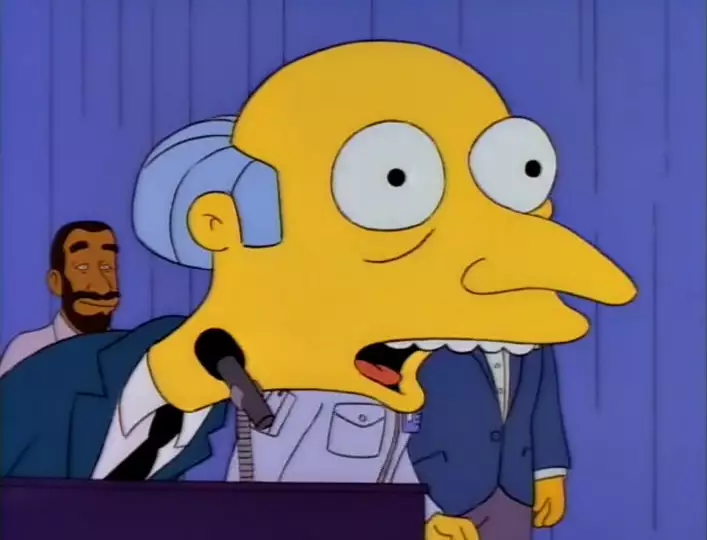
The extra character element helps to integrate the celebrity into the episode so their stunt casting is less obnoxious, but it is also useful for jokes. Mike Sostia Sauchya Scioscia’s earnest desire to run the solid contaminate encapsulator, and the resulting “send you back to the big leagues” line, come from the internal consistency of his Simpsonian character.
“Well, I never met you, but… yes” I love how each of Strawberry’s yeses are identical. It helps cement the “better than you” part as being as obvious as the “him being Darryl Strawberry” part and does that nice repetition thing for the joke.
This is the most we’ve seen Homer in about 5 minutes, which is a big chunk of a 20-minute show. This is part of what I’m talking about regarding the haphazardness of what’s under this episode’s hood. There’re pieces of familiar tropes, but none of them are connected and the vehicle only moves because you’ve hired 9 athletes to push it.
“and he already has more friends around the plant then I do” is another great line that connects Strawberry’s obvious baseball talents with Homer’s obvious lack of positive personality traits.
“No matter how good you are at something there’s always about a million people better than you” this is pretty much true, which is why you should pursue even competitive things for inner purposes.
Love the look on Homer’s face when Burns mentions him. Not one we see often.
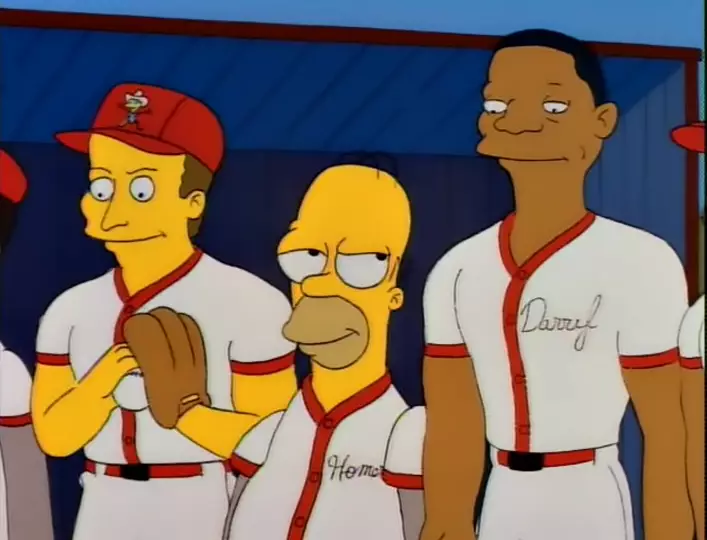
“Electromagnetic juices” is a great old-timey snake-oil phrase. I mean, I say old-timey but fuck me the medical quackery that gets about today is as bad. People buttchug bleach.
Burns as millionaire is funny but I’ve always found Burns’ turn of the last century stuff funnier.
Burns copping the bunt and being driven into the net is funnier for its minimalism. There is no excess sound, just the crispness of ball to bat, a strangely long silence to build anticipation and comedically suggest a long journey, and then the gentle rattling of the chain link. Terrific execution.
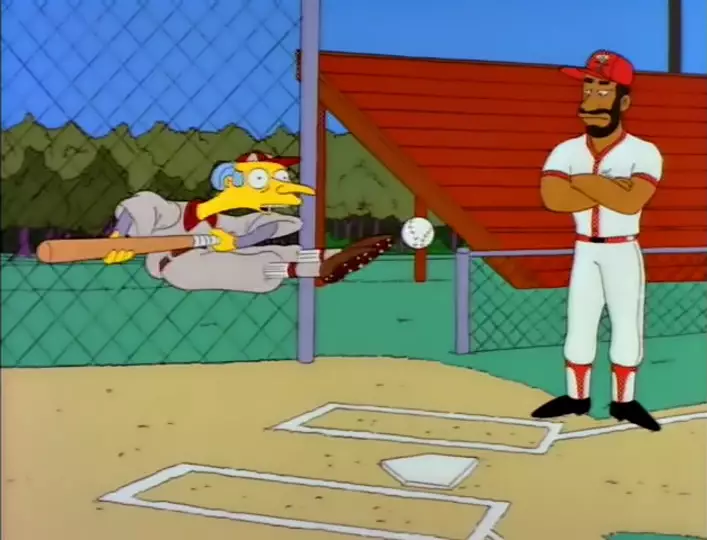
“Throw it on the pile, I s’pose” is basically what I’m doing with my stimulus money.
The Hypnotist was the Santa teacher but now he’s The Hypnotist. He never appears again.
All of the players repeating after the hypnotist were recorded separately and getting them to sync was a fucking pain.
Similar to the minimalism of the Burns bunt joke, Strawberry’s leaping catch is a perfect use of sound to sell the joke.
Strawberry being a teacher’s pet is another great use of in-universe character that makes him more interesting than most of the others.
There are some basic questions to ask about the scene where the pros wind up playing on Ralph’s team, like why Bart is playing baseball against an 8 year old Ralph, but these are easily ignored as it’s a scene that’s dedicated to a single joke concept, and the concept is funny. Just the way the pros, in gear, keep walking up right after Bart has stuck himself with Milhouse or Lewis.
The whole Burns and Mattingly thing with the sideburns is funny cause about a year later he actually got forced to cut his mullet in New York.
Burns just not knowing what sideburns even are is a goodun.
It’s a particularly odd inversion of the usual sports story that Homer’s threat isn’t Shelbyville or Shelbyville bringing in ringers, but his inability to play because his own team is doing that. This is part of what stunts the usual flow of the tropes, as Homer loses his magic bat a while before the triumph point of the narrative and it isn’t maintained as an emotional point. It just vanishes into irrelevance. Normally, its loss would be the point around which Homer’s self-doubt would congeal.
Clemens and Homer hating Strawberry’s ass kissing is good.
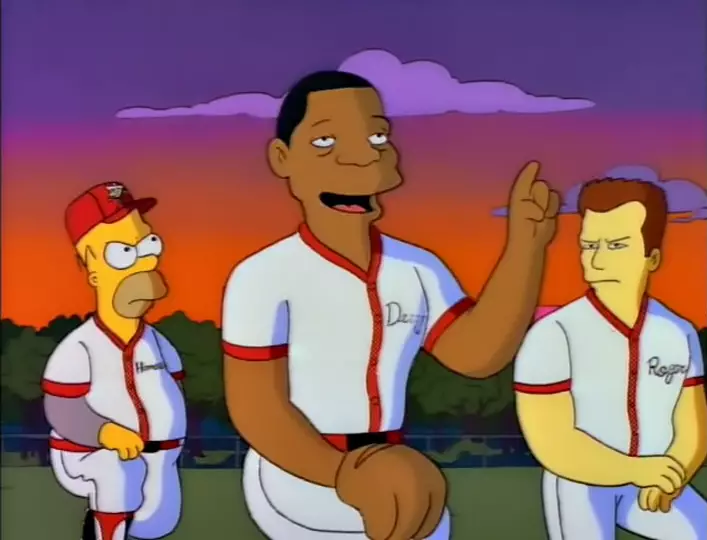
Homer isn’t picked because he is measurably, by a wide margin, worse than the other players. Thinking your skill was in a magic bat is a dramatic fault to be heroically overcome, genuinely sucking isn’t. This whole episode is a weird mishmash of parody and anti-trope that holds together in the same way a disorganised pile of Lego bricks counts as a pyramid model.
Clemens thinking Homer was Ken Griffey Jr is a goodun.
Burns’ thing about liking to see 9 misfortunes is the telling part of the show’s structure. The episode is really just a joke function writ large. The whole story has only used the temporary pieces of various narrative forms as setups for a big payoff gag.
I do love jokes like this, the big windup ones. There is a great one in the otherwise awful Anchorman 2. Don’t get me wrong, the movie is shit, but the long setup of the Winnebago crash involving a collection of bowling balls, operating deep fryers, and a scorpion collection, is fucking hilarious. Humour works on surprise, ruining surprise with an obvious setup is usually a problem, but when you lean into it so heavily you create a new surprise in how surprisingly overwrought the setup is. A good payoff is pretty necessary to the success of this format. The various misfortunes are funny, and the physical comedy of the Winnebago crash is wonderfully executed. Sealab 2021 did something similar involving a soda machine and a scorpion, actually.
Sax getting arrested is fairly dry, and the degree of real hostility from Eddie and Lou borders on frightening because there’s no countering tone.
Conversely, Mike Shoshanna’s leukemia is really funny because of his stilted delivery and the sudden sight gag of Ken Griffey Jr’s giant head.
“Good lord… GiGANtism” is a line that got around.
That he’s still drinking the tonic and that the nurse is looking at his head really get me here.
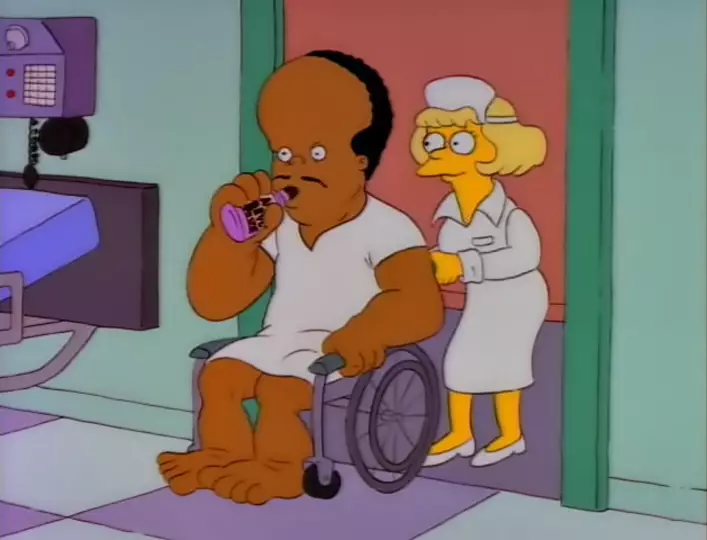
Canseco was originally going to be involved in some Bull Durham style affair with Mrs Krabappel, the scene was fully written, but Canseco (or his girlfriend, or Canseco using his girlfriend as an excuse) complained so he was given something heroic instead. Canseco’s head looks like one of those homemade German sausages where the skin is a little odd looking but only because you’ve never seen a sausage made with real intestines in your whole life.
The player piano gag is reasonably funny though.
The space required for the stunts and jokes leaves little left for things like Homer’s actual feelings. We skip straight to a moment between he and marge as he laments his inability to play, which lasts for 13 seconds.
“None of my friends can watch me” is a good joke, though.
Boggs and Barney arguing over greatest British PMs is a great piece of asinine drunk argument writing. It’s not so far from reality, given some of the ones I’ve seen or been in.
Barney’s “Lord Palmerston” is one of those things that sorta became a meme in the house and was what my brother or I would shout before whacking the other with something. This still works, and I recommend trying it on friends and family.
I fucking love the Springfield Mystery Spot. One of my favourite things in the world is floating equations, it’s such a bizarre thing but it has existed for a while, so nobody really thinks about it. But like, why? Why did someone decide to have an equation hurtling through space? Is it a sculpture? A raw manifestation of thought? What? All this makes them really funny to begin with, but that combined with the simplicity of the 3+3=6 in Rick and Morty makes me chuckle every time I see it.
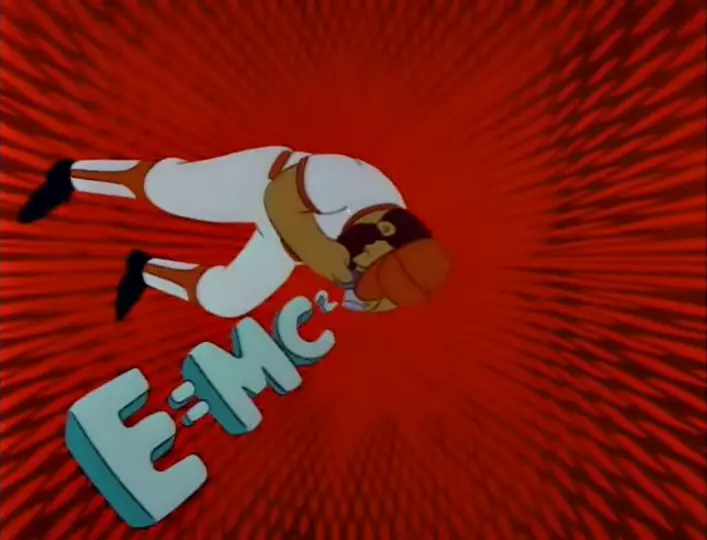
I also enjoy the Pertwee era time vortex Ozzie is floating through.
“The dryer goes on the right” is well into stupid territory but its brevity, and because it’s sandwiched between the Mystery Spot and the Clemens Chicken carry it.
It’s weird that the hypnotist can change Burns’ opinion of him but can’t fix Clemens.
“You hate me, and I hate you even more” is great.
Burns addressing them as a ragtag bunch of misfits is funny cause it’s basically what the trope is called.
We don’t even really see the Shelbyville team.
Apparently, the Darryl chant took off from this.
Love the peanut bag throwing, things landing in the parking lot is always funny.
I struggle to believe that the scores could be that close with Darryl Strawberry on the team. Like, I get that he can’t be everywhere, but still.
The ball sailing into traffic is a great extension on the peanuts in the carpark.
“I told him to do that” Ah, the self-congratulatory parasite class.
Homer’s ball scratching was an argument with Fox, then they went and looped it in the episode promo anyway. The “we’ll tell you, Mom” line is a lot funnier than just watching Homer scratch his nuts, cause we get the spaces between the prompts.
I’m assuming nine home runs in a game is an insane stat.
Again, there’s no dramatic reason for Homer to get a go at bat, to succeed, or anything like that because that time was taken up by misfortunes. Basically, the episode spent the time it would have taken to get the story to work getting the stunt part to work. This was worthwhile as there is room in a full season for some stunt episodes and this meant the stretching was taken care of.
“Not once, not twice, but THRICE” is so perfectly in character for Burns and still the most confusing way anyone could communicate that information. That’s good use of your tools. I also almost always pronounce thrice with the breathy importance Burns has here.
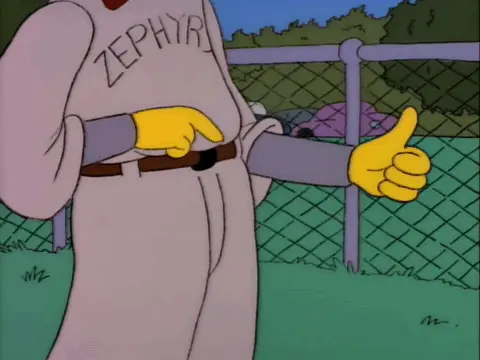
The slow zoom into Homer as he does what he does more than we see: smile, nod, and lament that he’s too stupid to understand something.
There’s a kind of clash with the final event. They can’t have Homer just win, even though he’s demonstrated he can belt the ball just fine and Shelbyville haven’t hired a bunch of ringers, because it doesn’t pay off or validate anything. Having Burns distract him is good, as its understandable, creates internal logic, and doesn’t invalidate his prior demonstrations of ability. But having him cop it in the head, while funny, is odd. It was sailing right for his head. He was standing still, had he been looking and swung at it, it would have still hit his head. It’s a very minor detail though.
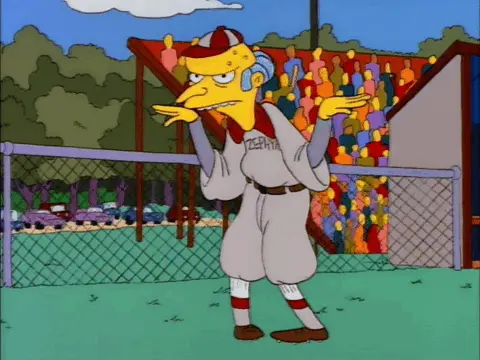
Perhaps we are just on the other side of a Shelbyville protagonists’ darkest moment, when he begins to question if he’ll ever pitch in local softball again.
Apparently, the beaning doesn’t count as a hit, but the resulting walk would have won the game anyway.
The end song, a parody of Talkin’ Baseball has some good lines in it and has been stuck in my head for about thirty years.
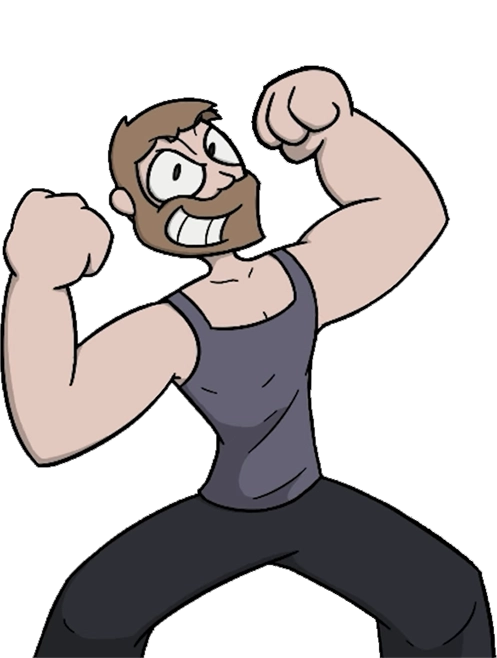

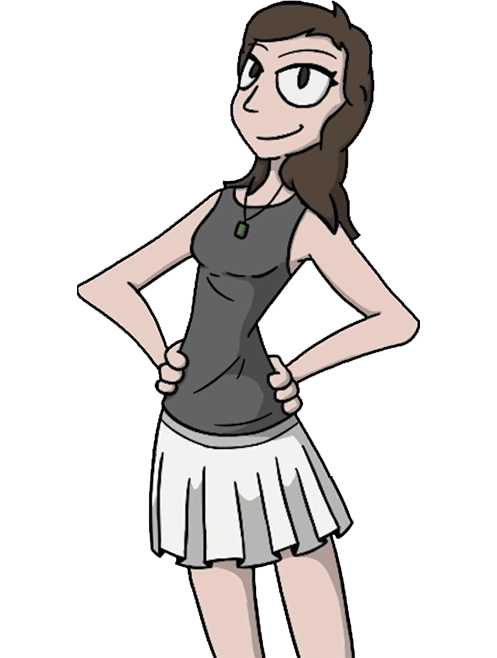
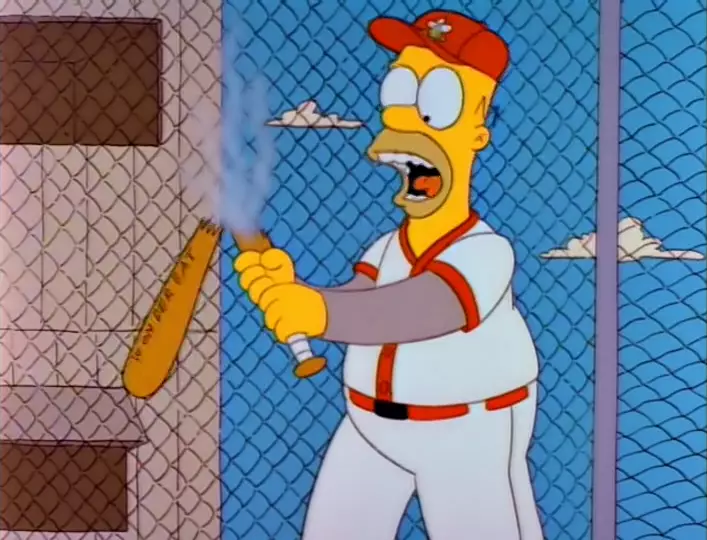

5 replies to Homer at the Bat
Magnumweight on 6th May 202006 May 20 said:
Whilst this isn't my favorite episode of the season, it's probably one of the most iconic episodes of the entire series, right up there with Last Exit to Springfield, Cape Feare, or Who Shot Mr Burns. I think the celebrity cameos work better in this episode better than most of the series, certainly more than late stage Simpsons, where it's more of a distraction than anything else.
Gabriel on 6th May 202006 May 20 said:
A big part of what I was wanting to tease out was the way they went to effort to get the celebrities to fit well, and how, at this stage of the series, that necessitated losing other elements of the narrative. Later episodes, during the good period, could play in the space left.
Last Exit to Springfield is probably my favourite episode. I can't wait to get to it.
Magnumweight on 8th May 202008 May 20 said:
I do enjoy me some Last Exit, though my favorite seems to shift from time to time. Cape Feare has more jokes that I enjoy, like the parade scene and, of course, the rakes, so it's probably my favorite at the moment.
SteelCladGamer on 6th May 202006 May 20 said:
I love Burns' old-timey baseball uniform.
Gabriel on 6th May 202006 May 20 said:
I've read that Zephyrs is a reference to a Twilight Zone episode, but the commentary track mentioned only not knowing what the outfit was about, so I'm not so sure.
Comment on Homer at the Bat
To reply, please Log in